Loch Katrine: Difference between revisions
Created page with "right|thumb|350px|Above Stronachlachar, eastward along the loch File:Loch Katrine by Alexander Nasmyth, 1810.JPG|right|thumb|250px|Loch Katrine by ..." |
mNo edit summary |
||
| (One intermediate revision by the same user not shown) | |||
| Line 2: | Line 2: | ||
[[File:Loch Katrine by Alexander Nasmyth, 1810.JPG|right|thumb|250px|Loch Katrine by Alexander Nasmyth, 1810]] | [[File:Loch Katrine by Alexander Nasmyth, 1810.JPG|right|thumb|250px|Loch Katrine by Alexander Nasmyth, 1810]] | ||
{{county|Perthshire}} | {{county|Perthshire}} | ||
'''Loch Katrine''' is a large freshwater loch in [[Perthshire]]. It is roughly | '''Loch Katrine''' is a large freshwater loch mostly in [[Perthshire]], with the north-western shores in [[Stirlingshire]]. It is roughly eight miles long by ⅔ of a mile wide and runs the length of Strath Gartney. | ||
It is in the south of the Highlands and so more easily accessible from the cities, for which reason, and for the beauty of the loch and its surroundings, Loch Katrine is a popular destination for tourists and day visitors from Glasgow and other nearby towns. | It is in the south of the [[Highlands]] and so more easily accessible from the cities, for which reason, and for the beauty of the loch and its surroundings, Loch Katrine is a popular destination for tourists and day visitors from [[Glasgow]] and other nearby towns. | ||
The loch derives its name from the term ''cateran'' from the Gaelic ''ceathairne'', a collective word meaning ''cattle thief''<ref>{{cite web|url=http://www.bbc.co.uk/iplayer/episode/b01jxv9s/Britains_Lost_Routes_with_Griff_Rhys_Jones_Highland_Cattle_Drovers/ |title=BBC 2, Britain's Lost Routes. Griff Rhys Jones, Documentary about Highland Cattle Drovers |publisher=Bbc.co.uk |date=2012-10-28 |accessdate=2013-12-28}}</ref> or possibly ''peasantry''. Historically this referred to a band of fighting men of a clan; hence the term applied to marauders or cattle-lifters. The most notorious cattle thief from hereabouts was Rob Roy MacGregor, who was born at Glengyle House at the northern end of the Loch. | The loch derives its name from the term ''cateran'' from the Gaelic ''ceathairne'', a collective word meaning ''cattle thief''<ref>{{cite web|url=http://www.bbc.co.uk/iplayer/episode/b01jxv9s/Britains_Lost_Routes_with_Griff_Rhys_Jones_Highland_Cattle_Drovers/ |title=BBC 2, Britain's Lost Routes. Griff Rhys Jones, Documentary about Highland Cattle Drovers |publisher=Bbc.co.uk |date=2012-10-28 |accessdate=2013-12-28}}</ref> or possibly ''peasantry''. Historically this referred to a band of fighting men of a clan; hence the term applied to marauders or cattle-lifters. The most notorious cattle thief from hereabouts was Rob Roy MacGregor, who was born at Glengyle House at the northern end of the Loch. | ||
| Line 14: | Line 14: | ||
Robert Roy MacGregor was born at the head of the loch. | Robert Roy MacGregor was born at the head of the loch. | ||
Today Loch Katrine is owned by Scottish Water and is the primary water reservoir for much of the city of [[Glasgow]] and its surrounding areas. The water level has been artificially raised by around | Today Loch Katrine is owned by Scottish Water and is the primary water reservoir for much of the city of [[Glasgow]] and its surrounding areas. The water level has been artificially raised by around six feet - the Loch can be drawn down by a maximum of seven feet in order to provide gravitational flow to the [[Milngavie]] water treatment works by way of two 26-mile long aqueducts and 13 miles of tunnel. Milngavie itself is situated at almost 400 feet above sea level - sufficient to provide adequate water pressure to the majority of [[Glasgow]] without the need for pumping. | ||
[[File:Glen finhlas.jpg|left|thumb|120px|Plaque to the Glen Finglas expansion, 1958]] | [[File:Glen finhlas.jpg|left|thumb|120px|Plaque to the Glen Finglas expansion, 1958]] | ||
| Line 21: | Line 21: | ||
Water levels are supplemented by a dam and short tunnel from [[Loch Arklet]], a reservoir located between Loch Katrine itself and [[Loch Lomond]], beside the road to [[Inversnaid]], this project was completed in 1914. A longer tunnel beneath Ben A'an which brings water from the Glen Finglas Reservoir was completed in 1958, with dam being completed in 1965. | Water levels are supplemented by a dam and short tunnel from [[Loch Arklet]], a reservoir located between Loch Katrine itself and [[Loch Lomond]], beside the road to [[Inversnaid]], this project was completed in 1914. A longer tunnel beneath Ben A'an which brings water from the Glen Finglas Reservoir was completed in 1958, with dam being completed in 1965. | ||
Oil-fired vessels are not permitted to sail its waters due to the danger of pollution to the drinking water of Glasgow. Instead a biodiesel fueled, steam-powered boat named the SS ''Sir Walter Scott'' offers local tourist transport between Trossachs Pier and Stronachlachar during summer. | Oil-fired vessels are not permitted to sail its waters due to the danger of pollution to the drinking water of Glasgow. Instead a biodiesel fueled, steam-powered boat named the SS ''Sir Walter Scott'' offers local tourist transport between Trossachs Pier and [[Stronachlachar]] during summer. | ||
==Villages beside the loch== | ==Villages beside the loch== | ||
[[File:Sròn a' Chlachair - Stronachlachar.JPG|right|thumb|200px|Stronachlachar with Factor's Isle]] | [[File:Sròn a' Chlachair - Stronachlachar.JPG|right|thumb|200px|Stronachlachar with Factor's Isle]] | ||
The main access points for Loch Katrine are either from [[Trossachs]] Pier at the loch's eastern end or Stronachlachar (Gaelic ''Sròn a' Chlachair'' "the headland of the stonemason") towards the western end of the loch. Trossachs Pier essentially consists of a parking space, pier, gift shop and café (Katrine Café) which are open from the first to the last sailing of the cruise boats, (normally 6pm).<ref>{{cite web|url=http://www.lochkatrine.com/ |title=The Loch Katrine Experience |publisher=Lochkatrine.com |date=2012-06-14 |accessdate=2013-12-28}}</ref> | The main access points for Loch Katrine are either from [[Trossachs]] Pier at the loch's eastern end in Perthshire; or [[Stronachlachar]] (Gaelic ''Sròn a' Chlachair'', "the headland of the stonemason") towards the western end of the loch in Stirlingshire. Trossachs Pier essentially consists of a parking space, pier, gift shop and café (Katrine Café) which are open from the first to the last sailing of the cruise boats, (normally 6pm).<ref>{{cite web|url=http://www.lochkatrine.com/ |title=The Loch Katrine Experience |publisher=Lochkatrine.com |date=2012-06-14 |accessdate=2013-12-28}}</ref> | ||
On the northern shore are the Brenchoile hunting lodge and the farms Letter (Gaelic: ''Leitir''), Edra (Gaelic: ''Eatarra'' "between them"), Strone (Gaelic: ''An t-Sròn'' "the nose"), Coilachra, Portnellan (Gaelic: ''Port an Eilein'' "port of the island") and Glengyle (Gaelic: ''Gleann Goill'' "glen of a lowlander"), on the southern are The Dhu (Gaelic: ''An Dubh'' "the black") at the western end of the loch, Stronachlachar, the Royal Cottage, Culligart and Glasahoile (Gaelic: ''Glas-choille'' "greywood"). | On the northern shore are the Brenchoile hunting lodge and the farms Letter (Gaelic: ''Leitir''), Edra (Gaelic: ''Eatarra'' "between them"), Strone (Gaelic: ''An t-Sròn'' "the nose"), Coilachra, Portnellan (Gaelic: ''Port an Eilein'' "port of the island") and Glengyle (Gaelic: ''Gleann Goill'' "glen of a lowlander"), on the southern are The Dhu (Gaelic: ''An Dubh'' "the black") at the western end of the loch, Stronachlachar, the Royal Cottage, Culligart and Glasahoile (Gaelic: ''Glas-choille'' "greywood"). | ||
| Line 50: | Line 50: | ||
[[Category:Lochs of Perthshire|Katrine]] | [[Category:Lochs of Perthshire|Katrine]] | ||
[[Category:Lochs of Stirlingshire|Katrine]] | |||
Latest revision as of 13:28, 17 March 2018
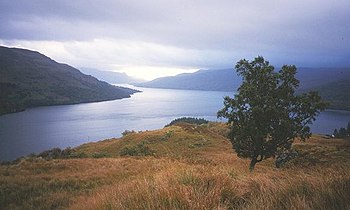
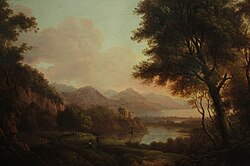
Loch Katrine is a large freshwater loch mostly in Perthshire, with the north-western shores in Stirlingshire. It is roughly eight miles long by ⅔ of a mile wide and runs the length of Strath Gartney.
It is in the south of the Highlands and so more easily accessible from the cities, for which reason, and for the beauty of the loch and its surroundings, Loch Katrine is a popular destination for tourists and day visitors from Glasgow and other nearby towns.
The loch derives its name from the term cateran from the Gaelic ceathairne, a collective word meaning cattle thief[1] or possibly peasantry. Historically this referred to a band of fighting men of a clan; hence the term applied to marauders or cattle-lifters. The most notorious cattle thief from hereabouts was Rob Roy MacGregor, who was born at Glengyle House at the northern end of the Loch.
The loch is the fictional setting of Sir Walter Scott's poem The Lady of the Lake and of the subsequent opera by Gioachino Rossini, La donna del lago.
History
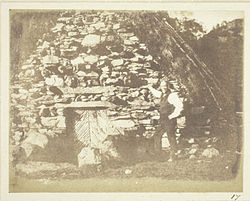
Robert Roy MacGregor was born at the head of the loch.
Today Loch Katrine is owned by Scottish Water and is the primary water reservoir for much of the city of Glasgow and its surrounding areas. The water level has been artificially raised by around six feet - the Loch can be drawn down by a maximum of seven feet in order to provide gravitational flow to the Milngavie water treatment works by way of two 26-mile long aqueducts and 13 miles of tunnel. Milngavie itself is situated at almost 400 feet above sea level - sufficient to provide adequate water pressure to the majority of Glasgow without the need for pumping.
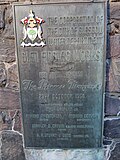
The system can deliver up to 50,000,000 gallons a day. Construction was started in 1855 and the works was opened by Queen Victoria in 1859. The aqueduct project was built under the guidance of the eminent Civil Engineer John Frederick Bateman (1810–1889), an example of his engineering prowess that can still be seen working today. The second aqueduct was opened in 1901.
Water levels are supplemented by a dam and short tunnel from Loch Arklet, a reservoir located between Loch Katrine itself and Loch Lomond, beside the road to Inversnaid, this project was completed in 1914. A longer tunnel beneath Ben A'an which brings water from the Glen Finglas Reservoir was completed in 1958, with dam being completed in 1965.
Oil-fired vessels are not permitted to sail its waters due to the danger of pollution to the drinking water of Glasgow. Instead a biodiesel fueled, steam-powered boat named the SS Sir Walter Scott offers local tourist transport between Trossachs Pier and Stronachlachar during summer.
Villages beside the loch
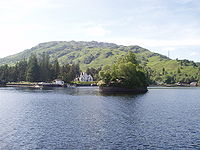
The main access points for Loch Katrine are either from Trossachs Pier at the loch's eastern end in Perthshire; or Stronachlachar (Gaelic Sròn a' Chlachair, "the headland of the stonemason") towards the western end of the loch in Stirlingshire. Trossachs Pier essentially consists of a parking space, pier, gift shop and café (Katrine Café) which are open from the first to the last sailing of the cruise boats, (normally 6pm).[2]
On the northern shore are the Brenchoile hunting lodge and the farms Letter (Gaelic: Leitir), Edra (Gaelic: Eatarra "between them"), Strone (Gaelic: An t-Sròn "the nose"), Coilachra, Portnellan (Gaelic: Port an Eilein "port of the island") and Glengyle (Gaelic: Gleann Goill "glen of a lowlander"), on the southern are The Dhu (Gaelic: An Dubh "the black") at the western end of the loch, Stronachlachar, the Royal Cottage, Culligart and Glasahoile (Gaelic: Glas-choille "greywood").
The roads and paths do not circle the loch completely, as the southern road stops at Glasahoile.
Islands
There are several small islands in Loch Katrine such as Ellen's Isle (Gaelic: An t-Eilean Molach "the shingly isle"), the Black Isle and Factor's Island (Gaelic: Eilean a' Bhàillidh).
Trivia
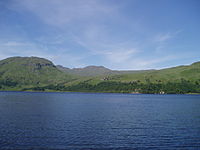
- Fly and boat fishing for trout is permitted on the loch from spring to autumn.
- The name 'Loch Katrine' is also borne by a lake in Canterbury, New Zealand.
- Loch Katrine inspired a popular bagpipe march: 'The Athole Highlanders' Farewell to Loch Katrine'.
- In 1844, William Henry Fox Talbot, pioneer of photography, took an early photograph of the lake, entitled Scenery of Loch Katrine.[3]
Outside links
| ("Wikimedia Commons" has material about Loch Katrine) |
- Location map: 56°15’16"N, 4°30’56"W
References
- ↑ "BBC 2, Britain's Lost Routes. Griff Rhys Jones, Documentary about Highland Cattle Drovers". Bbc.co.uk. 2012-10-28. http://www.bbc.co.uk/iplayer/episode/b01jxv9s/Britains_Lost_Routes_with_Griff_Rhys_Jones_Highland_Cattle_Drovers/. Retrieved 2013-12-28.
- ↑ "The Loch Katrine Experience". Lochkatrine.com. 2012-06-14. http://www.lochkatrine.com/. Retrieved 2013-12-28.
- ↑ "Fox Talbot's 1844 photograph of Loch Katrine". Birmingham Museum of Art. http://artsbma.org/collectionitemdetails?searchtitle=Scenery%20of%20Loch%20Katrine. Retrieved 30 September 2013.
- Newton, M. Bho Chluaidh gu Calasraid Acair 1999 ISBN 0-86152-265-6
